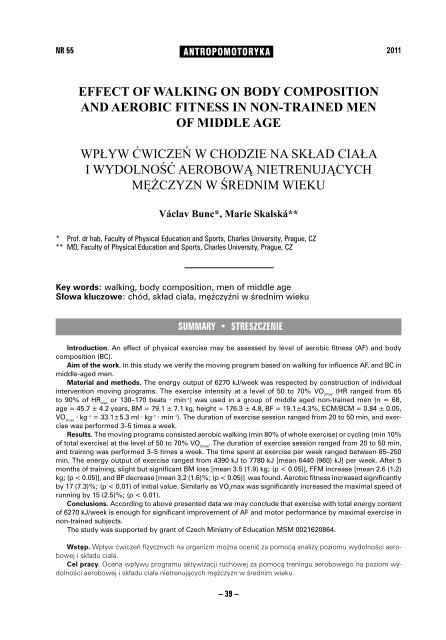Antropomotoryka nr 55.indb - Akademia Wychowania Fizycznego w ...
Antropomotoryka nr 55.indb - Akademia Wychowania Fizycznego w ...
Antropomotoryka nr 55.indb - Akademia Wychowania Fizycznego w ...
You also want an ePaper? Increase the reach of your titles
YUMPU automatically turns print PDFs into web optimized ePapers that Google loves.
NR 55 2011<br />
AN TRO PO MO TO RY KA<br />
EFFECT OF WALKING ON BODY COMPOSITION<br />
AND AEROBIC FITNESS IN NON-TRAINED MEN<br />
OF MIDDLE AGE<br />
WPŁYW ĆWICZEŃ W CHODZIE NA SKŁAD CIAŁA<br />
I WYDOLNOŚĆ AEROBOWĄ NIETRENUJĄCYCH<br />
MĘŻCZYZN W ŚREDNIM WIEKU<br />
Václav Bunc*, Marie Skalská**<br />
* Prof. dr hab, Faculty of Physical Education and Sports, Charles University, Prague, CZ<br />
** MD, Faculty of Physical Education and Sports, Charles University, Prague, CZ<br />
Key words: walking, body composition, men of middle age<br />
Słowa kluczowe: chód, skład ciała, mężczyźni w średnim wieku<br />
SUMMARY • STRESZCZENIE<br />
Introduction. An effect of physical exercise may be assessed by level of aerobic fitness (AF) and body<br />
composition (BC).<br />
Aim of the work. In this study we verify the moving program based on walking for influence AF, and BC in<br />
middle-aged men.<br />
Material and methods. The energy output of 6270 kJ/week was respected by construction of individual<br />
intervention moving programs. The exercise intensity at a level of 50 to 70% VO 2max<br />
(HR ranged from 65<br />
to 90% of HR or 130–170 beats · min–1 max<br />
) was used in a group of middle aged non-trained men (n = 68,<br />
age = 45.7 ± 4.2 years, BM = 79.1 ± 7.1 kg, height = 176.3 ± 4.8, BF = 19.1±4.3%, ECM/BCM = 0.84 ± 0.05,<br />
VO 2max<br />
· kg –1 = 33.1±5.3 ml · kg –1 · min –1 ). The duration of exercise session ranged from 20 to 50 min, and exercise<br />
was performed 3–5 times a week.<br />
Results. The moving programs consisted aerobic walking (min 80% of whole exercise) or cycling (min 10%<br />
of total exercise) at the level of 50 to 70% VO 2max<br />
. The duration of exercise session ranged from 20 to 50 min,<br />
and training was performed 3–5 times a week. The time spent at exercise per week ranged between 85–250<br />
min. The energy output of exercise ranged from 4390 kJ to 7780 kJ [mean 6440 (960) kJ] per week. After 5<br />
months of training, slight but significant BM loss [mean 3.5 (1.9) kg; (p < 0.05)], FFM increase [mean 2.6 (1.2)<br />
kg; (p < 0.05)], and BF decrease [mean 3.2 (1.6)%; (p < 0.05)] was found. Aerobic fitness increased significantly<br />
by 17 (7.3)%; (p < 0.01) of initial value. Similarly as VO 2<br />
max was significantly increased the maximal speed of<br />
running by 15 (2.5)%; (p < 0.01).<br />
Conclusions. According to above presented data we may conclude that exercise with total energy content<br />
of 6270 kJ/week is enough for significant improvement of AF and motor performance by maximal exercise in<br />
non-trained subjects.<br />
The study was supported by grant of Czech Ministry of Education MSM 0021620864.<br />
Wstęp. Wpływ ćwiczeń fizycznych na organizm można ocenić za pomocą analizy poziomu wydolności aerobowej<br />
i składu ciała.<br />
Cel pracy. Ocena wpływu programu aktywizacji ruchowej za pomocą treningu aerobowego na poziom wydolności<br />
aerobowej i składu ciała nietrenujących mężczyzn w średnim wieku.<br />
– 39 –





![Antropomotoryka nr 57 [2012]. - Akademia Wychowania Fizycznego ...](https://img.yumpu.com/50213388/1/182x260/antropomotoryka-nr-57-2012-akademia-wychowania-fizycznego-.jpg?quality=85)











